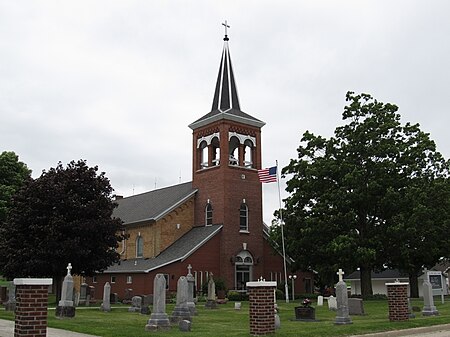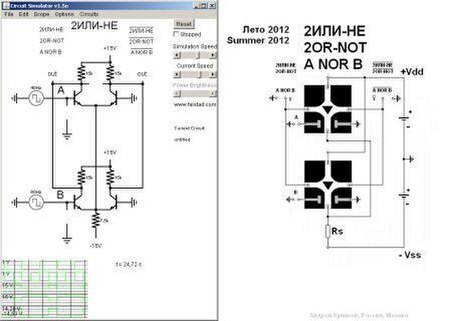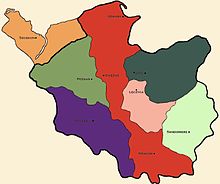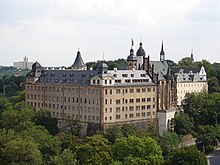Władysław II the Exile
| |||||||||||||||||||||||||||||||||||
Read other articles:

Italian school in Bogotá, Colombia Gimnasio Alessandro Volta is a private Italian international school in Usaquén, Bogotá, Colombia.[1] It has scuola infanzia (preschool) through secondaria II grado (upper secondary school).[2] References ^ Home page. Gimnasio Alessandro Volta. Retrieved on November 21, 2015. GIMNASIO ALESSANDRO VOLTA Cll. 119 No. 4-79 Usaquén[...]Bogotá - Colombia ^ SCUOLE PARITARIE ITALIANE ALL'ESTERO (Archive). Ministry of Foreign Affairs (Italy). p. 4/6.…

Qajar-era illustration of Salm, Iraj and Tur Salm and Tur receive the reply of Fereydun and Manuchehr, Miniature from the Shahnameh of Shah Tahmasp by Abd al-Aziz. Tabriz, c. 1530. Aga Khan Museum Salm (Persian: سلم) or Sarm[1] (Middle Persian) is a character in the Persian epic Shahnameh. He is the oldest son of legendary hero and king Fereydun. It is believed that his name was given to him by his father, after Salm chooses to seek safety and run instead of fighting the dragon that h…

QueauxcomuneQueaux – Veduta LocalizzazioneStato Francia Regione Nuova Aquitania Dipartimento Vienne ArrondissementMontmorillon CantoneLussac-les-Châteaux TerritorioCoordinate46°20′N 0°40′E / 46.333333°N 0.666667°E46.333333; 0.666667 (Queaux)Coordinate: 46°20′N 0°40′E / 46.333333°N 0.666667°E46.333333; 0.666667 (Queaux) Superficie54,82 km² Abitanti619[1] (2009) Densità11,29 ab./km² Altre informazioniCod. postale8…

أحمد المعتمد على الله أحمد بن جعفر بن محمد بن هارون بن محمد بن عبد الله بن محمد بن علي بن عبد الله بن العباس بن عبد المطلب دينار في عهد المعتمد ضرب في عام 271هـ معلومات شخصية الميلاد 844 (229 هـ)سامراء الوفاة 892 (279 هـ) (50 سنة)سامراء مكان الدفن سامراء مواطنة الدولة العباسية ا�…

「俄亥俄」重定向至此。关于其他用法,请见「俄亥俄 (消歧义)」。 俄亥俄州 美國联邦州State of Ohio 州旗州徽綽號:七葉果之州地图中高亮部分为俄亥俄州坐标:38°27'N-41°58'N, 80°32'W-84°49'W国家 美國加入聯邦1803年3月1日,在1953年8月7日追溯頒定(第17个加入联邦)首府哥倫布(及最大城市)政府 • 州长(英语:List of Governors of {{{Name}}}]]) • …

Сельское поселение России (МО 2-го уровня)Новотитаровское сельское поселение Флаг[d] Герб 45°14′09″ с. ш. 38°58′16″ в. д.HGЯO Страна Россия Субъект РФ Краснодарский край Район Динской Включает 4 населённых пункта Адм. центр Новотитаровская Глава сельского посел…

Samstag aus LichtOpera by Karlheinz StockhausenStockhausen in the WDR Studio, 1991LibrettistStockhausenLanguageGermanPremiereMay 25, 1984 (1984-05-25)Palazzo dello Sport in Milan, by La Scala Samstag aus Licht (Saturday from Light) is an opera by Karlheinz Stockhausen in a greeting and four scenes, and was the second of seven to be composed for the opera cycle Licht: die sieben Tage der Woche (Light: The Seven Days of the Week). It was written between 1981 and 1983, to a libretto …

Town in Wisconsin, United StatesLincoln, WisconsinTownLocation of Lincoln, WisconsinCoordinates: 44°37′55″N 87°35′1″W / 44.63194°N 87.58361°W / 44.63194; -87.58361Country United StatesState WisconsinCountyKewauneeArea • Total35.7 sq mi (92.4 km2) • Land35.7 sq mi (92.4 km2) • Water0.0 sq mi (0.0 km2)Elevation[1]745 ft (227 m)Population (2010) …

Town in Greece Demotica redirects here. For other uses, see Demotika. Dimotica redirects here. For other uses, see Dimotika. Municipality in Thrace, GreeceDidymoteicho ΔιδυμότειχοMunicipalityPanoramic view of Didymoteicho from the walls of the fortress May 2010. The structure with the pyramidal roof is the Çelebi Sultan Mehmed Mosque.DidymoteichoLocation within the region Coordinates: 41°21′N 26°30′E / 41.350°N 26.500°E / 41.350; 26.500CountryGreeceGeo…

Meteorological station in Greenland Eismitteclass=notpageimage| Location within Greenland Station Eismitte in 1930 The three scientists manning the station: Ernst Sorge, Fritz Loewe and Johannes Georgi with one of the aerosledges of the expedition. Eismitte, in English also called Mid-Ice, was a meteorological station established by the 1930-31 German Greenland Expedition in the middle of the Greenland Ice Sheet. The venture took place from July 1930 through August 1931, and established three Ar…

Type of emergency exit for tall buildings For the album by Sunburned Hand of the Man, see Fire Escape (album). For the story from Gordon the High-Speed Engine, see List of The Railway Series books. Fire escape in Greenwich Village Fire escape in a public building in Rotterdam A fire escape is a special kind of emergency exit, usually mounted to the outside of a building – occasionally inside, but separate from the main areas of the building. It provides a method of escape in the event of a fir…

Algorithm for finding zeros of functions This article is about Newton's method for finding roots. For Newton's method for finding minima, see Newton's method in optimization. An illustration of Newton's method. In numerical analysis, Newton's method, also known as the Newton–Raphson method, named after Isaac Newton and Joseph Raphson, is a root-finding algorithm which produces successively better approximations to the roots (or zeroes) of a real-valued function. The most basic version starts w…

Баллистические транзисторы — собирательное название электронных устройств, где носители тока движутся без диссипации энергии и длина свободного пробега носителей намного больше размера канала транзистора. В теории эти транзисторы позволят создать высокочастотные (ТГ�…

The K2Poster promosiGenreThriller Drama politik Romansa LagaDitulis olehJang Hyuk-rinSutradaraKwak Jung-hwan [ko]PemeranJi Chang-wook Song Yun-ah Im Yoona Jo Sung-haNegara asalKorea SelatanBahasa asliKoreaJmlh. episode16ProduksiLokasi produksiKorea Selatan SpanyolDurasi60 menitRumah produksiHB EntertainmentDistributortvN (2016)Trans TV (2020)NET. (2023)Rilis asliJaringantvN Trans TV, NET.Format gambar1080i (HDTV)Rilis23 September (2016-09-23) –12 November 2016 (2016…

الإذاعة المصريةمعلومات عامةالبلد مصر التأسيس 1934 النوع إذاعة المقر الرئيسي مبنى الإذاعة والتلفزيون المصري أهم الشخصياتالرؤساء سعيد باشا لطفي (1934 – 1947)محمد بك قاسم (1947 – 1950) تعديل - تعديل مصدري - تعديل ويكي بيانات بدأ البث الإذاعي في مصر في عشرينيات القرن العشرين وكانت عبا�…

2017 European Athletics U23 ChampionshipsTrack events100 mmenwomen200 mmenwomen400 mmenwomen800 mmenwomen1500 mmenwomen5000 mmenwomen10,000 mmenwomen100 m hurdleswomen110 m hurdlesmen400 m hurdlesmenwomen3000 msteeplechasemenwomen4 × 100 m relaymenwomen4 × 400 m relaymenwomenRoad events20 km walkmenwomenField eventsHigh jumpmenwomenPole vaultmenwomenLong jumpmenwomenTriple jumpmenwomenShot putmenwomenDiscus throwmenwomenHammer throwmenwomenJavelin throwmenwomenCombined eventsHeptathlonwomenDec…

The Left Banke es una banda americana de rock y pop barroco que se formó en la Ciudad de Nueva York en 1965, se disgregó en 1969, se reformó en 2011 y otra vez en 2015, sin el cantante principal original Steve Martin Caro.[1][2] Son recordados sobre todo por sus dos éxitos en sencillo de EE. UU. , Walk Away Renée y Pretty Ballerina.[3] La banda utiliza a menudo lo que la prensa musical denominaba como arreglos de cuerda barrocos , lo que llevó a su música a ser d…

Assedio di PaviaCavalleria carolingia. Illustrazione del salmo 60 nel Golden Psalter of St. Gallen, c. 890.Datasettembre 773 - 5 giugno 774 LuogoPavia EsitoVittoria decisiva franca Modifiche territorialiAnnessione del regno longobardo da parte dei Franchi SchieramentiRegno francoRegno longobardo ComandantiCarlo MagnoBernardoDesiderio Effettivi10 000 - 40 0002 500 - 10 000 Voci di battaglie presenti su Wikipedia Manuale L'assedio di Pavia fu condotto dalle armate del re franco Carlo Magno[…

Art school in Manhattan, New York Art Students' League redirects here. For the building occupied by the organization, see American Fine Arts Society. For the school started by Thomas Eakins, see Art Students' League of Philadelphia. The American Fine Arts Society Building at 215 West 57th Street The Art Students League of New York is an art school in the American Fine Arts Society in Manhattan, New York City. The Arts Students League is known for its broad appeal to both amateurs and professiona…

18th Indian general election in NCT of Delhi 2024 Indian general election in Delhi ← 2019 25 May 2024 2029 → ← outgoing membersAll 7 Delhi seats in the Lok SabhaOpinion pollsTurnout58.69% ( 1.91%) First party Second party Third party Leader Manoj Tiwari Arvind Kejriwal Jai Prakash Agarwal Party BJP AAP INC Alliance NDA INDIA INDIA Leader since 2021 2012 2022 Leader's seat North-East Delhi Not Contesting Chandni Chowk Last electio…


